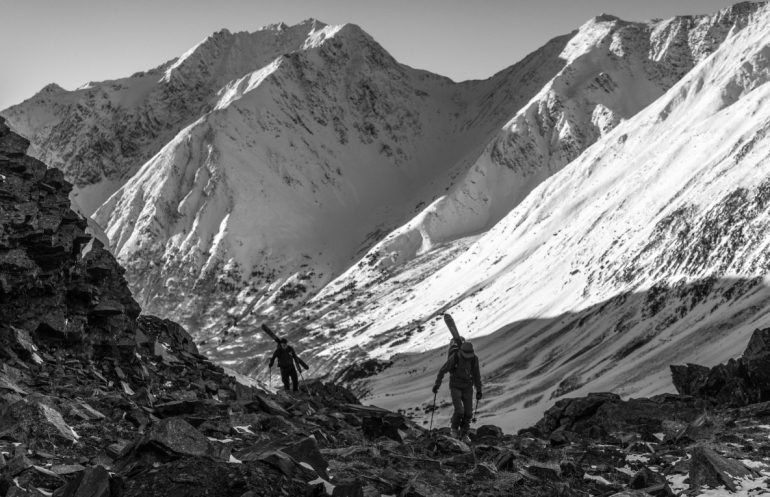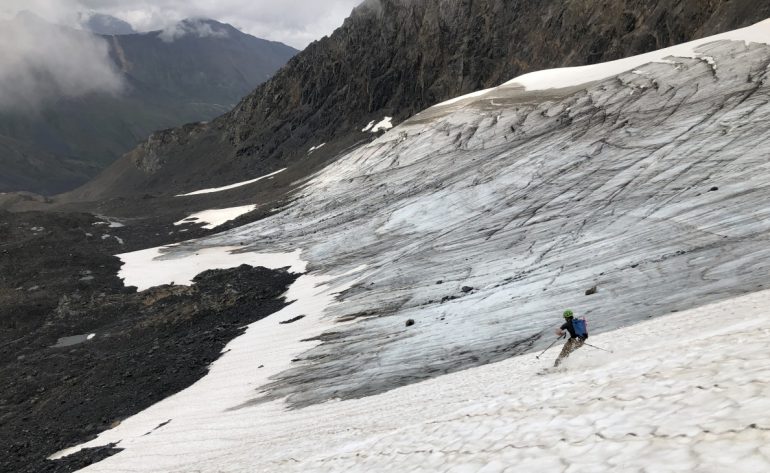Last week, we woke to a surprise at WildSnow HQ: a strong dusting of late-summer snow, reaching as low as 9000 feet. That snowfall has since melted, but it brought to mind this piece Alex Lee wrote a few years back that asks the ever-important question: When does next snow year begin? Read, enjoy, add to the discussion. — M
Contemplating when one snow year ends and another begins
The small glaciers lingering in the more accessible corners of the mountains around Anchorage, Alaska are rapidly receding, turning to dirty patches of ice that get painted with ski turns as soon as the first snow of the fall flies. I went skiing a couple weeks ago and it was everything I hope for in September turns: rocky, short, difficult, bad snow with a long approach and lots of weird looks at the trailhead.
Hoofing skis up high for a few turns was a good reminder of how out of shape I get in the off-season, how grateful I am for rock skis, and how much fun sliding around on snow is. I was sure this outing was a last ditch effort to get in summer turns while hiking up the tundra in a t-shirt, but wishing I had bigger gloves once we got up to 4000 ft made me wonder if this wasn’t the first bit of next year’s season. The snow was new, but then again, there’s always new snow somewhere. It was after equinox, but before the start of the 2020 fiscal year.
So, with the rain outside my office window right now turning to snow above 1000 ft, and with the storage wax starting to come off skis across town: is it next year yet?
This question may only plague a crazy few, but the way I see it, there are 7 compelling ways to divide one season from the next:
The calendar year: Okay, I know this sounds ridiculous. I mean surely December turns shouldn’t be lumped together with spring skiing from the May prior. We even refer to seasons with a dash splitting two calendar years, as in “2019-2020.” While I agree that there is likely little support for the calendar year dividing ski seasons, there may still be reasons worth considering. Skiing before New Years is typically thin and sketchy. With core shots likely and avalanches running to ground, perhaps we have been too eager for next year, and such skiing is really meant to round out the previous 12 months. An additional benefit to the calendar year is that it means there is no gap between seasons.
The hydrological year: Running October 1st through September 30th, the U.S. Geological Survey considers precipitation measurements part of contiguous water year. There are many appealing reasons to adopt the water year as the standard demarcation between ski seasons; snow, after all, is frozen water. September turns are never really that good, and occasionally an October surprise can yield proper pow skiing. The NRCS SNOTEL sites, tracking snowpack in North America, run on the water year. Conveniently, the water year also aligns with the U.S. Government fiscal year.
The school year: Most school districts and universities in North America are in session from September through May. Most ski turns in North America are made between September and May. Most North American school holidays, family routines, and daydreaming for adventure occur between September and May. I may be biased as a college professor here, but the school year provides a reasonable demarcation. June, July, and August, or as we school-connected folks call it, ‘summer’ is a different season both climatologically and emotionally. Summer skiing often feels like its own sport anyways, and the conventional split between summer and school year aligns with the appropriate ratio of ski-season to dog-walking-season (4:1).
Deferral to the nearest chairlift: Maybe this whole time you have been reading this thinking, “wait a second, most skiers don’t start touring until Thanksgiving!” Well perhaps the best way to distinguish one season from the next is to defer to the nearest ski resort. Once a chairlift is running, an actual ski operator has had to stamp their profit-driven approval on the commencement of the season. In the U.S. this conveniently aligns well with Thanksgiving.
The rule of ablation: I have asked several ski partners to weigh in, and I have most often heard that once you are skiing snow that will stick around until the following melt season, a new year has begun. For most of North America this is happens sometime in late October, but one of the challenges of this rule is the variation, even locally. Suppose I am skinning up a valley where the lower elevations will melt, but the snow up high will stick – have I skinned from one season to the next? Then again, the few corners of our continent still offering refuge for year-round winter would have to be considered as continually existing in one eternal ski season, which sounds rather dreamy to me.
The winter tire rule: A simple rule that offers some flexibility year-to-year, while also offering a clear start to the season is the change of your tires. I usually switch to winter tires in early November, which feels reasonable. A benefit of the winter tire rule, is that it allows for the subjectivity of personal choice. If you don’t want to head up into the mountains for another month or two, then just run those bald summer tires until the skis call to you. Apologies to you ‘all-season’ folks out there, you’re just not committed enough to winter travel take part in ski season yet.
Equinox: Since skiing is really an ineffable pursuit, it is only reasonable to consider an astronomical demarcation for the start of our season. After the third week in September, the days in the northern half of the globe are more dark than light. Summer has officially become fall – the equinox offers an intuitive divide. I like the simplicity of equinox, but also feel that there is something nice about counting September towards last year’s quota.
Other possible considerations beyond the list above could be Canadian Thanksgiving (the second Monday in October), the first frost in town, the end of Daylight Savings Time (early November), or your nearest showing of TGR’s newest film. I seem to remember landing on October 15th once, but I am not sure why.
I am rather conflicted about which norm to adopt, what do you think? Has a new ski season begun?
For more fodder on the more nuanced aspects of skiing and mountain life, check out our other stories.
Dr. Alex Lee lives in Anchorage, Alaska. Alex is a professor at Alaska Pacific University, teaching philosophy and environmental studies. He also works as a sometimes guide, naturalist, writer, and photographer.


